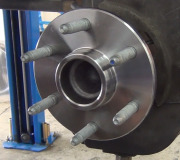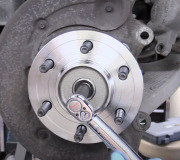My wondrous reply requires a pile of typing, so to avoid doing that over and over, here is a partial copy of a previous reply to get our discussion started:
... There's one more important thing to be aware of that only applies to GM front-wheel-drive cars. When pedal-bleeding with a helper, or after replacing calipers or pads, never, never, ever press the brake pedal more than half-way to the floor. That is proper procedure for any car or truck when the master cylinder is more than about a year old because corrosion builds up in the lower halves of the two bores where the pistons don't normally travel. Pressing the pedal to the floor runs the lip seals over that crud and can rip them causing a slowly sinking pedal and eventual failure of the master cylinder. But there's a more important reason on GM fwd cars. Most fwd cars use a "split-diagonal" brake hydraulic system. Instead of a front and a rear system like we've had since the 1960s, the left front and right rear are on the same hydraulic circuit. GM master cylinders have a valve that trips to block off two ports when one circuit doesn't build the same pressure as the other one. That happens when one circuit has a leak but it will also occur when you stroke the pedal to push the pistons out of the caliper housings. One piston will naturally come out first and when the pads contact the rotor, that side will start to build pressure. Since the other piston hasn't moved as far yet, no pressure will build and that valve will trip. From that point on, no matter how hard you press the brake pedal, no fluid will come out of that caliper and the opposite rear wheel cylinder. The service manual says that can be avoided by pedal-bleeding the wheel in a specific sequence, but they lied. That valve will trip if ANY wheel builds pressure while ANY wheel does not.
Once that happens, many people identify the master cylinder as the reason they can't get brake fluid from two wheels and they replace it, then run into the same problem when bleeding the new one. This can happen even when not bleeding anything. Just pumping the pistons out after replacing the front pads can cause this problem. The only way I have ever found to reset that valve is go to one of the wheels that isn't flowing fluid and give a very short, quick burst of compressed air through the opened bleeder screw, then let it gravity-bleed.
Some owners don't even notice when that valve has tripped. Suspension geometry and alignment angles have been modified on front-wheel-drive cars so there will be no brake pull when one side isn't applying. On Chryslers you'll never see the slightest hint of a pull. On most GMs, all you'll see is a slight wiggle of the steering wheel as the brake pedal is being applied. A fairly common complaint on GMs is those new front brake pads wore out too quickly on one side and the other side looks like brand new. That's because the one side is never applying and one side does all the stopping. Some people don't ask for help until they've gone through two or three pairs of pads, then they figure out something is wrong. All this can be avoided by never pushing the brake pedal more than half-way down to the floor.
Okay, I'm back. As for your front calipers, GM has had very little trouble with theirs so lets not worry about them unless it appears they're causing a problem. Here is a previous reply about brake fluid contamination. By the way, please don't call this "brake oil". I know this is nit-picking, but other people might read this and see "oil" and take that to mean engine oil can be used. Brake fluid is a glycol product and is absolutely not compatible with petroleum-based products. More importantly, it's the rubber used in brake systems that is not tolerant of petroleum products. Here's the reply from earlier. Most of this is for information only. Lets hope we don't have to go down this road:
... IIf the fluid is contaminated with petroleum product the car is probably not worth repair. The first clue is the rubber bladder seal under the reservoir cap will be blown up and mushy. All the rubber parts in the hydraulic system will be grown the same way. The lip seals inside the master cylinder will grow past the fluid return ports and block them. That keeps the trapped fluid under pressure and unable to return to the reservoir, and that keeps the brakes partially applied. The excessive heat buildup from driving the car like that makes the brake fluid get real hot and expand. Since the fluid is trapped, when it expands, it applies the brakes harder. Eventually the car will barely move and one or two wheels will get real hot, both symptoms you're describing now.
The only proper fix is to remove everything with rubber parts, flush and dry the steel lines, then install new parts. That includes replacing the new calipers and wheel cylinders, all rubber flex hoses, the combination valve, and the master cylinder. If any part, such as the new calipers, are left on the car, the contamination will leach out of the seals and recontaminate the new fluid.
Every week we read about someone who accidentally put power steering fluid, engine oil, or transmission fluid in the master cylinder but there are other ways to contaminate the fluid. One problem that was more common years ago was repacking front wheel bearings, then wiping hands on a rag, then reseating the bladder seal into the cap when refilling the master cylinder. The grease residue on fingertips is enough to contaminate the system.
Another problem showed up many years ago at a mass merchandiser. A new mechanic wiped out a funnel used for engine oil, then used it to fill a brake pressure bleeder ball. The residue in the funnel contaminated five gallons of brake fluid and many cars.
Experienced brake mechanics will even wash their hands with soap and water before touching any seal or other rubber parts they're working on. Also, they will never use penetrating oil to free up rusted fittings in the brake system.
Brake fluid can be contaminated with water too but that won't cause the rubber parts to swell. That will simply lower the boiling point from well over 400 degrees to closer to 212 degrees, and it will promote corrosion of metal parts but that's all. Moisture contamination comes from leaving the master cylinder cap off or the cap off the bottle of new fluid. Brake fluid sucks humidity out of the air, and it will absorb some over time in the car's hydraulic system.
Lets hope you don't find contaminated fluid. It's fairly common to find rust buildup inside crimp fittings and brackets on flex hoses restricting them so fluid can be pumped to a caliper but it takes a long time to release. Often the additional clue is the brake pedal is higher and harder than normal when you press it.
I'm back again. If you see brake fluid leaking from a connection, that should be addressed first. Wash the area with a spray can of Brake Parts Cleaner. That will dry very quickly, then you can watch if any wetness shows up and where it's coming from. A leaking rubber flex hose is most common. Look for a cracked outer casing that lets you see the inner rubber hose and reinforcing strings. The inner rubber hose contains the brake fluid. The outer harder rubber casing contains the pressure which can easily reach over 2000 psi. If that inner hose bursts, the next time you push the brake pedal, that valve I mentioned that only GM uses, trips and will block further fluid flow from that hose. That's why you won't see a puddle like we did years ago or on other car brands.
The second suspect, based on your observation of where you're seeing the wetness, is the two copper washers on either side of the brass block on the end of the hose. A hollow "banjo" bolt goes through that block, and the copper washers seal it. Those rarely leak on their own. They almost always leak after someone had the hose disconnected and they didn't install new washers.
A quick way to tell if both of your front brakes are working is to try to lock up the brakes on sand or gravel. Observe if both front tires made skid marks. If only one did, you'll need to do the compressed air procedure I mentioned, but don't waste your time with that until the cause of the fluid leak has been solved. Let me know what you find and what you need help with next.
Wednesday, September 30th, 2015 AT 7:38 PM



